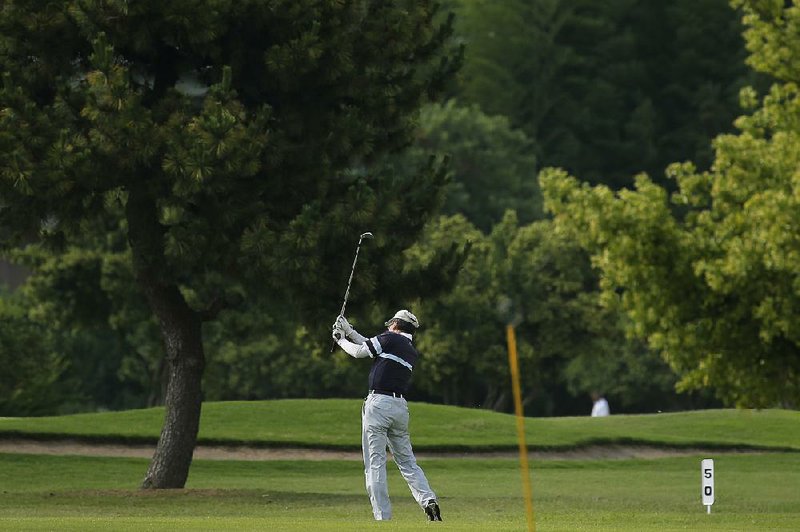Once the sport that epitomized the business cliques that dominated Japan's industrial might and global trade, golf has suffered a steady decline. The number of players in the country has slumped 30 percent from its heyday in the early 1990s; the average cost of a round has fallen by a third; sales at courses have shrunk by half.
"There's a sense of crisis," said Masahiro Kuramoto, chairman of the Professional Golfers' Association of Japan. "There's no doubt the market is shrinking."
Golf is a microcosm for the problems that Prime Minister Shinzo Abe is facing in reviving Japan's economy -- low prices, unwilling consumers, a lack of female participation and an aging populace. The sport generated $11.5 billion in sales for Japan's courses, driving ranges and equipment retailers in 2013, less than half the revenue of the peak years.
To stem the decline, courses need to appeal more to women, families and those looking to pick up a recreational hobby, said Kuramoto, whose friends call him Mr. 59 -- his score during a round on Japan's professional tour in 2003, a feat not matched by legends like Tiger Woods and Jack Nicklaus.
Nicklaus, winner of the most major tournaments in a career, has said golf is suffering globally because the game takes too long and is too difficult and costly to play.
U.S.-based Dick's Sporting Goods Inc. restructured its golf business last year, saying the sport's retail industry was in structural decline. Adidas AG said in August it may sell its Adams unit for beginners' clubs and Ashworth golf apparel brand.
Nowhere has that decline been more marked than in Japan.
"Golf is becoming obsolete," Tatsuo Sonoda, 61, said after playing a round with friends in June. "Compared with the bubble period, it has changed."
Back in the late 1980s and early 90s, new company hires would get golf lessons as part of their training, and lines of recruits would stand by phones to book tee-off times for their bosses at courses that were often more than 60 miles from Tokyo.
As their own games improved, they'd have to rise at 3 a.m. to pick up senior executives before driving two hours or more to a course. They had to arrive before the clients, who would be presented with gifts of new golf balls, clubs or attire. As the game progressed, they needed to be good enough to always lose to the client by only a few strokes.
The rituals made the game synonymous with the excesses of the bubble era, putting off younger players. The number of golfers over 70 has increased by 1 million during the past decade, according to Japan's Professional Golfers' Association.
"Golf in Japan has an image problem," said Hiroshi Tezuka, who owns seven courses across the country. "Golf paid for by your company is bad, golf for entertaining clients is bad, golf as a status symbol just by having the membership is bad, golfing and sacrificing the family is bad."
As the aura vanished, so did the money.
When Japan's property bubble burst, foreign investors, including buyout firm Lone Star Funds and Goldman Sachs Inc., bought hundreds of failing courses and restructured them. The two firms sold their golf-course operating companies to the public via share sales in 2005 and 2006.
In all, about 200 courses closed around the country, many of them after filing for bankruptcy. Some were just too far from the city to attract players who could now afford to play in the suburbs.
Those that remain face the challenge of getting customers to the course as car ownership among the younger generation declines.
"The car and golf are inseparable," says Sonoda, who drove his Lexus to play at Tezuka's Higashi Abiko Country Club in Chiba, 30 miles from Tokyo. He said his sons, 29 and 30, aren't interested in either golf or owning a car. His playing partner, Hirotaro Fukuoka, a 49-year-old doctor from Setagaya, said his two teenage children prefer cycling and hiking.
Courses are trying to change that, offering a courier service to bring clubs to the course, while players take the train, or striking alliances with rental-car companies for discounted rides.
Since last year, college kids sitting down to lunch at campus cafeterias have been courted with offers of free golf for a year once they turn 20.
Tezuka encourages married couples or boyfriend-girlfriend pairings with discounts. In the first week of August, during the school vacation, he opens the grounds for playing soccer, sledding down grass slopes or fishing in the water hazards, while parents drive around in golf carts.
While course owners used to ban beginners until they'd hit 10,000 balls on the driving range, Tezuka said he's looking at creating special tees that shorten the course for newbies.
Even the strict dress code is under threat. Courses in Okinawa and Tochigi hold "Jeans Day" and the lowest score of the day wins a new pair of jeans.
Progress is slow. Tezuka's seven courses averaged 17 or fewer 20-year-old players a month through March.
If young Japanese don't take to the sport soon, more courses could go the way of Toba Country Club in Mie prefecture and Suwa Golf Club in Nagano.
They're being converted into solar farms.
SundayMonday Business on 09/14/2015

